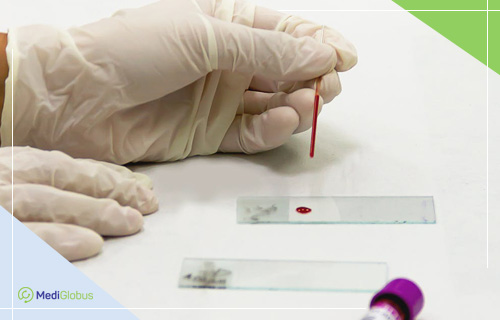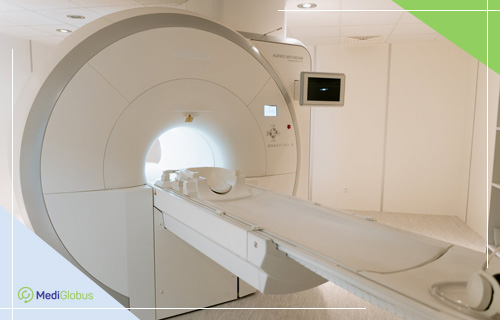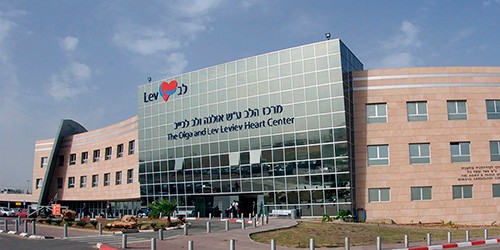1. What is monocytic leukaemia? |
2. Symptoms |
3. Diagnosis |
4. Cancer management |
5. Prognosis for survival |
6. Leading clinics |
Monocytic leukaemia is a malignant haematological disease characterised by an increase in monocytic cells in the blood and bone marrow. The pathology is divided into acute and chronic forms. It occurs most frequently in children and people over 50 years of age. The exact cause of the disease is unknown. It is thought that mutations in the DNA of the bone marrow, caused by exposure to chemicals, carcinogens, radiation or infection can trigger the disease. For more information on the symptoms, diagnosis and treatment of monocytic leukaemia, read this article.
Listen to the article:
What is monocytic leukaemia?

Monocytic leukaemia is a malignancy of the blood and bone marrow. It is a type of myeloid leukaemia. The disease involves the replacement of healthy blood cells with monocytes – the large white blood cells responsible for the body’s innate immunity.
Elevated monocyte levels make it difficult for all human systems to function. The bone marrow cannot work properly and produces too many immature blood cells. Over time, those abnormal cells displace platelets and red blood cells, leading to anaemia and impaired blood clotting. Specific malignant neoplasms appear in some organs.
Monocytic leukaemia is divided into acute and chronic types. The first variant is more common, but still, it accounts for no more than 1% of all malignant pathologies.
In the chronic form of monocytic leukaemia, the blood cells mature partially and slowly increase in number. For months or even years, the disease remains asymptomatic or has few clinical signs. The diagnosis is usually discovered in patients over 50 years of age. Twice as many men are affected as women.
Acute monocytic leukaemia involves a rapid accumulation of immature blood cells. It is one of the most common types of leukaemia in adults. It is rapidly progressive and has symptoms in the early stages. It is predominantly diagnosed in the elderly. The average age of diagnosis is 65-68 years. It can also affect children under 5 years of age.
What are the symptoms of monocytic leukaemia?
Chronic and acute forms of monocytic leukaemia have similar symptoms. However, in the first case, they may appear several years after the oncopathology has developed and may be less pronounced. In the second, the clinical picture is immediate and rapidly increasing. The main signs of monocytic leukaemia include:
rapid fatigue due to developing anaemia (lack of healthy red blood cells in the blood to transport oxygen throughout the body),
skin haemorrhages, bruising, nosebleeds, bleeding gums caused by reduced platelet levels,
shortness of breath, dizziness and fainting,
frequent infections,
enlarged lymph nodes,
enlarged spleen and liver,
night sweats,
muscle and bone pain,
fever,
skin rashes,
worsening of appetite and weight loss.
Diagnosis of monocytic leukaemia
The first diagnostics that are ordered for suspected monocytic leukaemia are blood and bone marrow tests. They reveal abnormal values for white blood cells, platelets and red blood cells.
The blood picture in chronic monocytic leukaemia suggests an increased number of monocytes (above 1,000/µl). Platelet and leukocyte counts are normal or slightly reduced. Eosinophils, white blood cells that form in the bone marrow and then enter the bloodstream, may be elevated.
The blood picture in acute monocytic leukaemia shows a significant increase in monocytes. At the same time, patients also show decreased platelet and erythrocyte levels.

Bone marrow diagnosis involves two examinations, which are usually carried out simultaneously: a lumbar puncture (removal of a cerebrospinal fluid sample) and a trepan biopsy (taking a small amount of bone filled with bone marrow). In the acute form, more than 20% of monocytic cells are found in the bone marrow; in the chronic form, 5-20%.
Additional diagnostic options for monocytic leukaemia are:
MRI, CT scan and PET-CT are used to measure the extent to which the malignant process has spread to organs and systems (spleen, liver, lymph nodes).
Abdominal ultrasound – shows an enlargement of the spleen, liver and lymph nodes as well as fluid in the abdomen.
Chest X-ray and echocardiography show fluid in the pleural cavity and pericardium.
To make an appointment for a diagnosis of monocytic leukaemia abroad, please contact the medical coordinators of the international medical platform MediGlobus. Our experts will find the most suitable clinic for your requirements.
How is monocytic leukaemia treated?
Treatment for monocytic leukaemia involves chemotherapy, the use of targeted or immune drugs, radiation and bone marrow transplantation (BMT). Depending on the form of the disease, cancer control programmes differ slightly.
Acute monocytic leukaemia is difficult to treat. Polychemotherapy (a combination of several antitumor drugs) and bone marrow transplants are considered the first-line treatment. In half of the cases, BMT is required. The chemotherapy regimen depends on the age and general health of the patient.
The patient first receives induction chemotherapy. This is the use of high doses of chemicals to kill as many cancer cells as possible. Usually, 4 to 6 courses are needed at intervals of 3 to 4 weeks. The drugs are given intravenously or in tablet form.
If remission is achieved with induction chemotherapy, the patient is given consolidation therapy. This involves the use of several less aggressive antitumour drugs. This is to consolidate the results of the previous treatment and to prevent a relapse. The duration of therapy is 2-4 months. Radiation and targeted or immune drugs can also be used.
In cases where patients have not responded to chemotherapy and other treatments have proved ineffective, a bone marrow transplant is recommended. This makes it possible to replace damaged blood cells with healthy ones. Generally, cells from a related donor (a sister or brother) are used for the transplant. Transplantation of the patient’s stem cells is also possible. However, this greatly increases the risks of the disease relapsing.
Treatment of chronic monocytic leukaemia includes high-dose chemotherapy and a BMT from a related or unrelated donor. In the second case, suitable bone marrow can be found in the International Donor Registry. Foreign clinics have access to this registry and can quickly find a donor.
This is done by performing an HLA typing – a study of the tissue compatibility of the donor and recipient. Based on these results, bone marrow is selected from the donor database with the highest possible cell match.
Prolonged use of less intensive chemotherapy with hypomethylating agents, which trigger the maturation process of immature blood cells, is also possible. This slows down the progression of the disease and reduces the need for blood transfusions (as maintenance therapy).

The prognosis for monocytic leukaemia
The prognosis for 3-year survival in the acute form of the disease is conditionally unfavourable. About 33% of patients pass this threshold. This is because the pathology has a rapid course and predominantly affects elderly people with comorbidities. In chronic monocytic leukaemia, the rate is 60%.
Where is monocytic leukaemia treated abroad?
Resume
Monocytic leukaemia is a malignant pathology of the blood and bone marrow. It affects adults and children. The disease is more common among men. The blood count for monocytic leukaemia is high, but the number of monocytes is low and the number of erythrocytes and thrombocytes is low.
Blood and bone marrow tests as well as abdominal ultrasound, CT, MRI and PET-CT are used to diagnose the disease.
Chemotherapy and BMT are the key methods of controlling the disease. Patients may also receive radiation (for brain, spleen or liver damage and to reduce muscle and bone soreness), immune or targeted therapy.
The overall prognosis for 3-year survival in acute monocytic leukaemia is around 33% and 60% in chronic leukaemia.
To make an appointment for treatment of monocytic leukaemia abroad, click on the button below and leave your contact details. We will call you back as soon as possible and help you with your medical problem.











